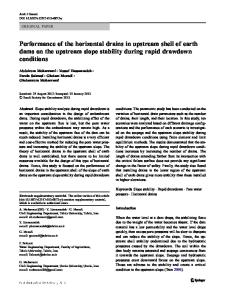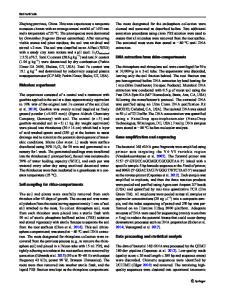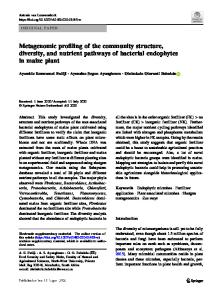Bacterial community structure upstream and downstream of cascade dams along the Lancang River in southwestern China
- PDF / 2,468,017 Bytes
- 15 Pages / 595.276 x 790.866 pts Page_size
- 35 Downloads / 319 Views
RESEARCH ARTICLE
Bacterial community structure upstream and downstream of cascade dams along the Lancang River in southwestern China Xia Luo 1,2 & Xinyi Xiang 1,2 & Guoyi Huang 1,2 & Xiaorui Song 1,2 & Peijia Wang 1,2 & Yuanhao Yang 1,2 & Kaidao Fu 1,2 & Rongxiao Che 1,2 Received: 16 December 2019 / Accepted: 16 July 2020 # The Author(s) 2020
Abstract Extensive construction of dams by humans has caused alterations in flow regimes and concomitant alterations in river ecosystems. Even so, bacterioplankton diversity in large rivers influenced by cascade dams has been largely ignored. In this study, bacterial community diversity and profiles of seven cascade dams along the720 km of the Lancang River were studied using Illumina sequencing of the V3-V4 hypervariable region of the 16S rRNA gene. Spatiotemporal variations of bacterial communities in sediment and water of the Gongguoqiao hydroelectric dam and factors affecting these variations were also examined. Microbial diversity and richness in surface water increased slightly from upstream toward downstream along the river. A significant positive correlation between spatial distance and dissimilarities in bacterial community structure was confirmed (Mantel test, r = 0.4826, p = 0.001). At the Gongguoqiao hydroelectric dam, temporal differences in water overwhelmed spatial variability in bacterial communities. Temperature, precipitation, and nutrient levels were major drivers of seasonal microbial changes. Most functional groups associated with carbon cycling in sediment samples decreased from winter to summer. Our findings improve our understanding of associations, compositions, and predicted functional profiles of microbial communities in a large riverine ecosystem influenced by multiple cascade dams. Keywords Bacterial community . Water . Sediment . Spatiotemporal distribution . Cascade dam construction . Lancang River . Responsible Editor: Diane Purchase
Introduction Bacteria are crucial to biogeochemical processes in all aquatic ecosystems (Feng et al. 2009; Sekiguchi et al. 2002). These microprobes dominate aquatic ecosystems in abundance, Responsible editor: Diane Purchase Electronic supplementary material The online version of this article (https://doi.org/10.1007/s11356-020-10159-7) contains supplementary material, which is available to authorized users. * Kaidao Fu [email protected] * Rongxiao Che [email protected] 1
Institute of International Rivers and Eco-Security, Yunnan University, Chenggong University Town, Chenggong New District, Kunming 650500, Yunnan Province, China
2
Yunnan Key Laboratory of International Rivers and Transboundary Eco-Security, Kunming 650500, China
diversity and metabolic activity, and function in essential ecological processes, such as the remediation of polluted environments (Savio et al. 2015). Several recent studies indicate that bacteria may be sentinels of environmental change (Harnisz 2013; Wang et al. 2012b) given their sensitivity to changing conditions (Savio et al. 2015). Typically, dam construction will affect o
Data Loading...











